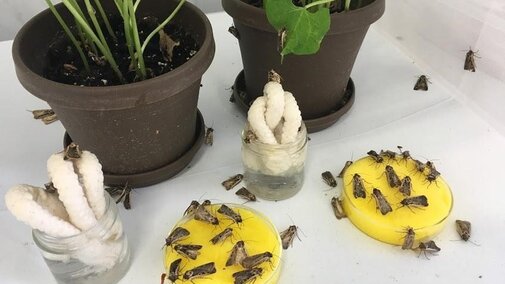In the Agroecosystems Entomology Laboratory at the West Central Research and Extension Center in North Platte, we conduct experiments that address the ecology and management of agricultural pests in field crops. The western bean cutworm (WBC) is an important pest of corn and dry beans that can negatively impact both crop quantity (yield) and quality. As such, WBC is a major focus of our research program. We have spent the past several summers conducting experiments to assess WBC growth and development, plant-to-plant and within-plant movement of WBC, the efficacy of insecticides and Bt traits at controlling WBC at various infestation rates, and potential biological control for WBC.
WBC can be a challenging insect to study, in part, because it has only one generation per year. WBC spends the winter as prepupae, a quiescent or resting stage, and then pupates and completes development during the following spring and early summer. Adult moths start to emerge in early July in Nebraska and females lay eggs on corn or dry beans during July and August. In corn, larvae prefer to feed on fresh tassel tissue right after hatching and will later move to protected areas of the plant to feed on whorl tissue, pollen, and/or silks before moving into and feeding on developing ears. Once WBC larvae have eaten enough and reached their final instar, they will drop off the plant in late summer or early fall and burrow into the soil where they will spend the winter as prepupae, starting the cycle over again. Because WBC are active for only two to three months each year, we have limited time during the summer months to conduct research.
One way to overcome this hurdle and to extend our research season is to establish a WBC colony in the laboratory. Our WBC colony is one of only three colonies in the world, making this a unique resource to be able to conduct research on this critical pest for Nebraska. In general, lab colonies such as ours can also play a vital role in field research. Because WBC populations vary from year to year at a site and egg-laying may vary with planting date, having a reliable WBC population available in the laboratory increases the likelihood that field experiments will be successful. For example, when WBC infestation rates in some experimental plots were not high enough this past summer, we used female and male moths from our colony to infest corn plants in those plots by confining them in large sunflower pollination bags placed over the whorl until females laid eggs.
The successful rearing of an insect species in the laboratory involves providing the insects with suitable substitutes for environmental resources that they need to complete their life cycle, such as food, shelter, and egg-laying sites. Débora Montezano, a PhD student in our lab, has worked over the past three years to adapt and optimize WBC rearing methods that were originally developed by researchers at Iowa State University. Along with Montezano, Priscila Colombo da Luz, a visiting scientist from Brazil, has been organizing and maintaining the WBC colony in our laboratory this year. Priscila received her master's degree in zoology at the University of Brasília and brings with her several years of experience related to rearing insects in the laboratory, moth species in particular. She is one of several Brazilian scientists who have visited our lab in the past few years to conduct research.
The photos show the major steps involved in raising WBC moths in the laboratory, including collecting adult moths in the field (Figure 1), providing adults with proper nutrition and egg-laying substrates in the laboratory (Figure 2), collecting egg masses (Figure 3), providing larvae with an artificial diet (Figure 4), and caring for larvae as they eat and grow (Figure 5), prepare to pupate (Figure 6), and “overwinter” as prepupae (Figure 7) under controlled environmental conditions (Figure 8) in the laboratory. Currently, we estimate we have almost 5,000 WBC individuals in our colony and are looking forward to using the next generation of WBC in laboratory experiments this fall.

-

Figure 1. Walk-in cages for western bean cutworms. (Photos by K. Swoboda Bhattarai and P. Colombo da Luz)
These cages were adapted by Bob King from prototypes deployed in 2016 and set up at seven sites in Nebraska. A black light on top of each trap attracts adult WBC moths at night. These moths are intercepted by panels on the light and funneled downward into the trap. Pots with pinto bean plants are placed in the trap to provide WBC adults with shelter and a place for females to lay eggs. Adults are regularly collected by hand or by using a hand-held vacuum modified for insect collection and brought to the laboratory.
-
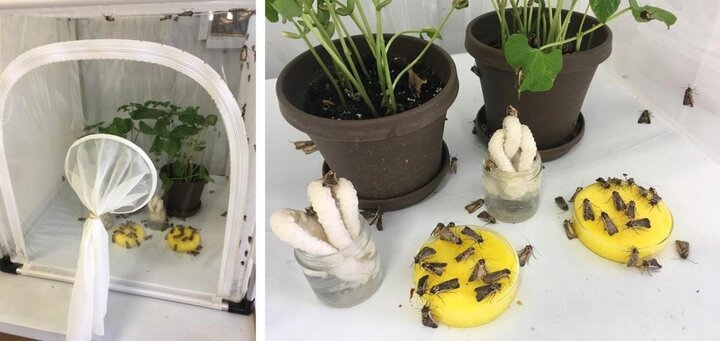
Figure 2. Oviposition cages in the laboratory. (Photos by P. Colombo da Luz)
Adult moths collected at each site are placed into separate oviposition cages in the laboratory. Moths are provided with an artificial nectar solution (yellow dishes), water, and pinto bean plants on which to lay eggs.
-

Figure 3. WBC egg masses on bean leaves (top left); egg masses collected from oviposition cages in the lab (bottom left); Priscila Colombo da Luz transferring neonate larvae onto artificial diet (right). (Photos by K. Swoboda Bhattarai and P. Colombo da Luz)
Plants are checked regularly for eggs masses, which are removed from leaves and placed into Petri dishes until the eggs hatch. Newly hatched larvae, called neonates, are carefully transferred with paint brushes into new Petri dishes containing a small cube of artificial diet.
-
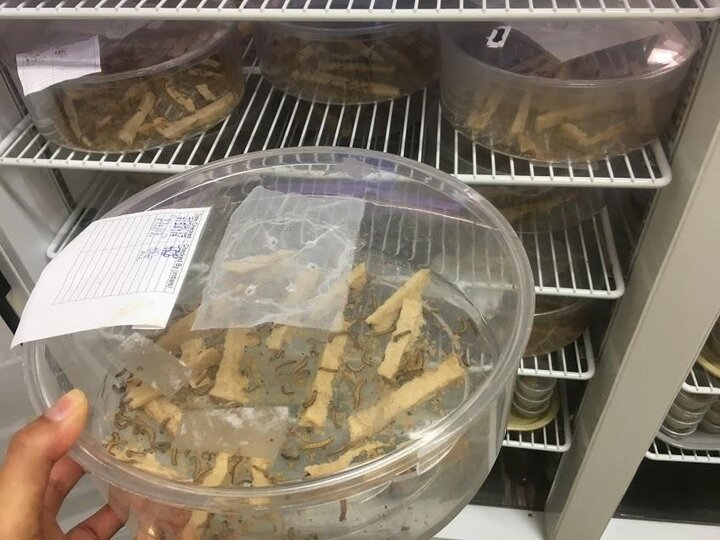
Figure 4. Large dishes of medium-sized WBC larvae in the incubator. (Photos by P. Colombo da Luz)
WBC generally has six larval instars, ranging from tiny neonates to nearly two-inch long sixth instars. Because they are not cannibalistic like some other caterpillars (corn earworm and fall armyworm (Spodoptera frugiperda), for example), it is possible to rear multiple WBC larvae in the same dish with strips of artificial diet. Artificial diet for WBC is made from a mixture of water, commercially available caterpillar diets (primarily containing bean protein and other nutrients), agar (to solidify the diet), and an antimicrobial (to prevent spoilage of the diet and clear infections from the caterpillars).
-
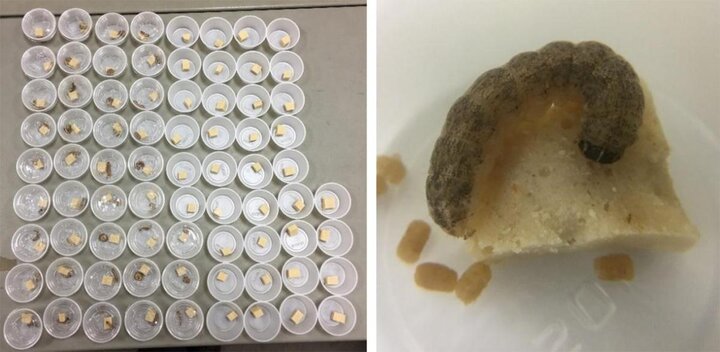
Figure 5. Later instar western bean cutworm larvae in individual cups (left); a larva feeding on a diet cube with pellets of frass in the bottom of the cup (right). (Photos by K. Swoboda Bhattarai and P. Colombo da Luz)
Large larvae are “individualized” and moved into small plastic cups with a vented lid and a cube of diet.
-

Figure 6. A final instar WBC digging into sand to make its overwintering chamber (top left) and the hole left behind on the surface of the sand (top right). Once its chamber is complete, the larva will enter the prepupal stage (bottom left) and stay safe inside its chamber and pupate once conditions are right. (Photos by K. Swoboda Bhattarai and P. Colombo da Luz)
Larvae about to enter the prepupal stage are gray and appear somewhat waxy when they are transferred into individual portion cups containing moist play sand. In the field, final instar larvae drop off the plant and build an earthen chamber in the soil in which to pupate using secretions from their salivary glands. Sandier soils allow larvae to burrow deeper into the soil, which may increase their chance of surviving cold winter temperatures and management practices such as tillage.
-
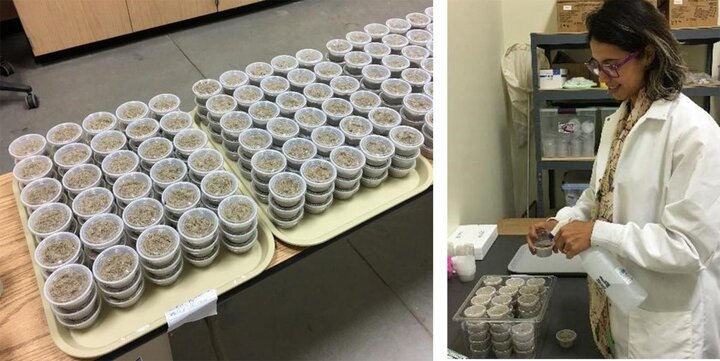
Figure 7. Trays of WBC prepupae (left); Priscila Colombo da Luz checking prepupae to maintain appropriate moisture (right). (Photos by K. Swoboda Bhattarai)
Because maintaining adequate humidity is very important for prepupal viability, water is added to each cup periodically. The prepupal stage under colony conditions lasts for 35-45 days, after which WBC prepupae transition to the pupal stage and emerge as adults, starting the process over again.
-

Figure 8. Incubators in the Agroecosystems Entomology Lab full of WBC larvae and prepupae. (Photos by K. Swoboda Bhattarai and P. Colombo da Luz)
Prepupa are housed in growth chambers under controlled conditions: approximately 78ºF during 16 hours of light and at 72ºF during 8 hours of darkness and 75% relative humidity.
//
